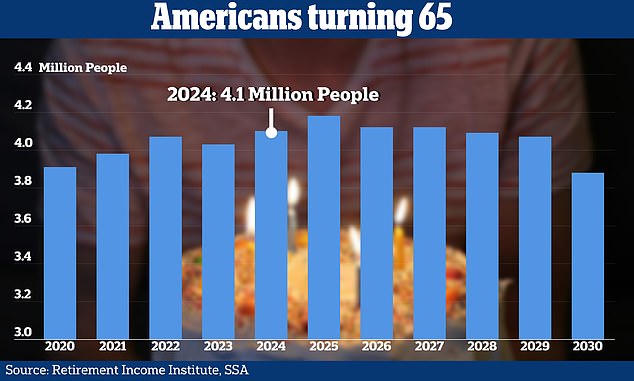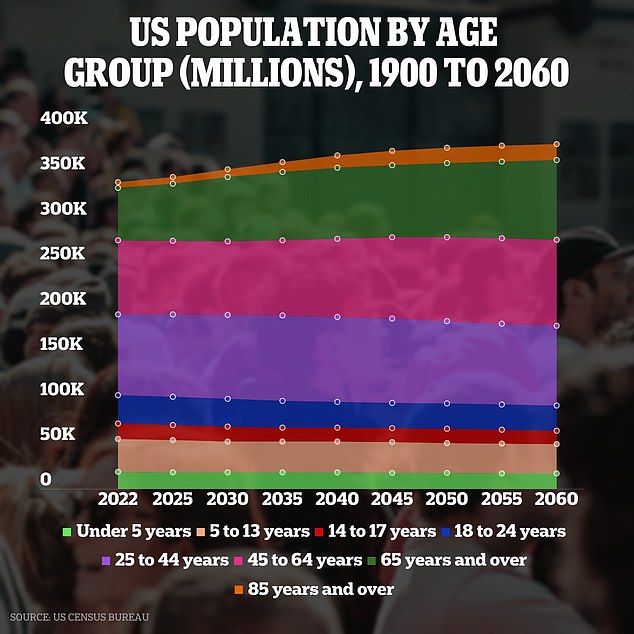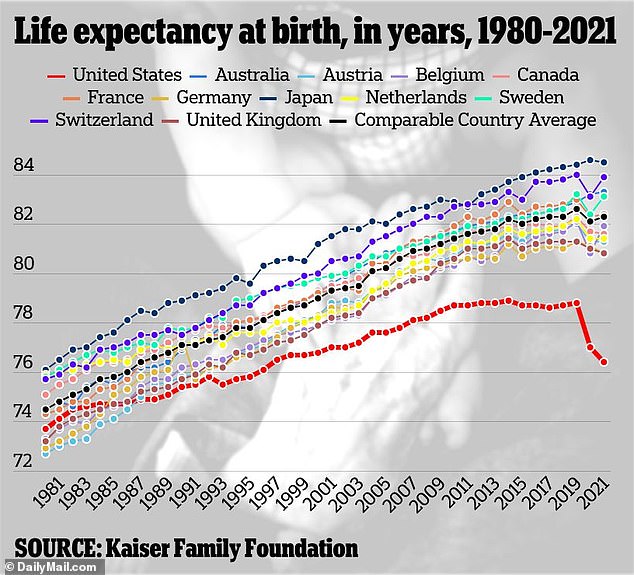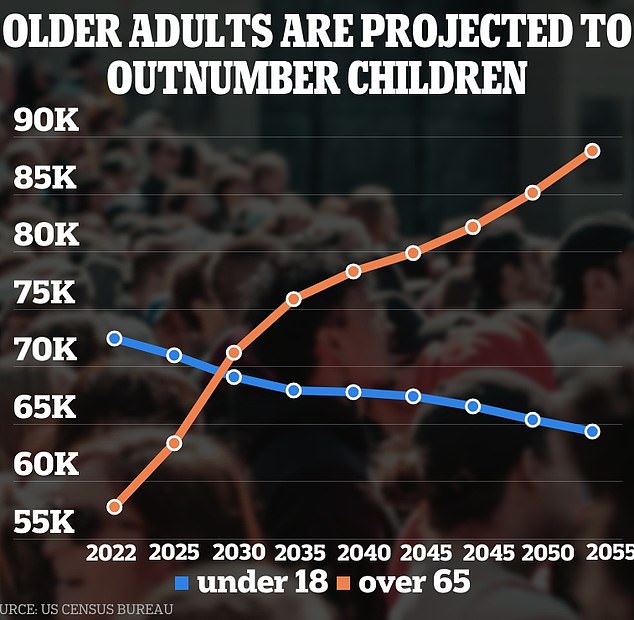Within six years, seniors are expected to outnumber children for the first time in U.S. history, as experts warn the country is about to grapple with a dramatically aging population.
The “silver tsunami” has already seen the burden on people of working age double since 1960, when there were six workers for every person over 65.
And millions now risk having no one to help them as the low-paid care industry is displaced by better-paid jobs in a tight labor market.
“The already difficult landscape in the senior care sector is likely to get worse unless action is taken,” said Dr. Kylie Meyer, an associate professor at Case Western Reserve University in Ohio. news week.
“More seniors may be left without care, or younger family members may be financially pressured to help their older relatives.”
There will be more people over 65 than under 18 for the first time in U.S. history by 2030, the U.S. Census Bureau predicts, and the trend will increase for the rest of the century.

A record 4.1 million Americans will turn 65 this year, as the last member of the Baby Boomer generation reaches retirement, and one in four Americans will be over age 65 in 2060.

Dr. Kylie Meyer, an assistant professor at Case Western Reserve University, warned that the growing elderly population will struggle to find the care they need to live a normal life.
Economists have been warning for decades about the impacts of the demographic time bomb, but the situation has worsened since the Covid-19 pandemic triggered the “Great Retirement,” with two million more people deciding to call it quits.
Half of the wealth in the United States is now in the hands of people born before 1965, a study found last year, helped by decades of rising housing prices and declines in the relative wages of the youngest.
But for those without assets or with complex health needs, the outlook is bleak.
Around 20 million people over the age of 55 already need help with daily tasks to lead an independent life.
But a study by the Schwartz Center for Economic Policy Analysis found that nearly eight million of them receive no aid at all.
Actuaries warned last year that the Social Security trust fund is expected to be depleted by 2034, and spending on welfare and Medicare is projected to rise from 9.1 percent of U.S. GDP to 11.5 in just 12 years.
And America’s changing age profile means that by 2030 there will be only 2.75 people of working age for every person of dependent age, if children are included.
“As the enormous population of Baby Boomers retires, we enter a period in which millions of highly experienced, high-performing workers transition from producers to consumers,” said economist Ron Hetrick of the research firm Lightcast market.

Americans will turn 65 at a record pace: 11,200 per day in 2024

‘A large number of retirees is not a problem in itself; The problem is the proportion of retirees compared to new workers.
“That’s because when people retire, their demand for goods and services is still high, but now we will have significantly fewer people to provide those goods and services in the future.”
The problem is not limited to the United States, as most developed countries experience an aging population, including Japan, whose population is expected to shrink by 30 percent by 2070, when four in ten will be over 65. years.
The situation is so dire in South Korea that Oxford University professor David Coleman predicted the entire country would become extinct at the current rate by the year 2750.
And even China, which recently lost its status as the world’s most populous nation to India, is now shrinking at a rate of nearly a million people a year.
And an older population is generally a sicker population, with greater demands for health services and care.
“Thanks to advances in medical technology, people are living longer than ever,” said Dr. Gary Small of Hackensack University Medical Center in New Jersey.
“Unfortunately, our bodies and brains were not designed to function efficiently during the current average lifespan, so people live longer, but not necessarily better.
‘Alzheimer’s disease, diabetes, cancer and many other age-related diseases cause disability and dependency, and there are relatively fewer adult children than ever available to help with care.
“The economic and emotional toll of these trends is daunting.”
U.S. Census Bureau projections predict that one in four Americans will be over age 65 by 2060, and that the number of people age 100 and older will surpass one million by the end of the century.
The percentage of the adult population retired has skyrocketed from 15 percent in 2007 to just under 20 percent, accelerating sharply since 2020 and defying Federal Reserve predictions.
“The impending demographic shift, in which older Americans will outnumber children for the first time in history, presents significant social and economic challenges and opportunities,” said Patrick Mish of the social work firm SilverStay.
“This change, often called the ‘silver tsunami,’ is expected to profoundly affect multiple facets of society.
‘As the population ages, demand for healthcare services will increase substantially, particularly those related to age-related diseases such as dementia, arthritis, heart disease and cancer.
“This will require a significant expansion of healthcare infrastructure and services, including more specialized care facilities and services.”

The US age profile is expected to continue aging despite the significant reduction in life expectancy during the Covid-19 pandemic.
But a study last year by the Pew Research Center found that nearly 20 percent of people over 65 were employed in 2023, nearly double the number in 1990.
A record 4.1 million Americans will turn 65 this year, at an average rate of 11,200 per day.
“Peak 65 is a historic moment,” said Cyrus Bamji, chief strategy officer at Alliance of Lifetime Income.
“The end of the Baby Boomer generation is starting to turn 65, and sadly, most of them are retiring unprotected, with a safety net full of holes.”


